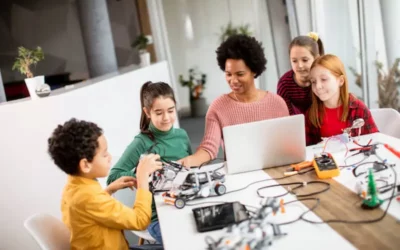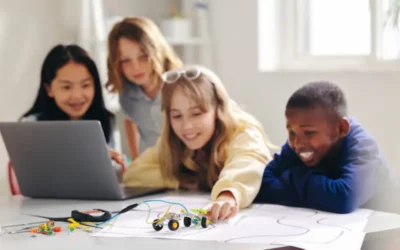Hey there, young explorers! Ever wondered about those cool machines that can move, talk, and sometimes even dance? Well, that’s what we call robotics! Imagine having your own little buddy that can follow your commands, almost like magic. That’s the world of robotics, where we make machines come alive with a sprinkle of technology and a dash of creativity. So, buckle up for a fun ride into the awesome land of robotics, where gadgets get a mind of their own, and you get to be the wizard behind the curtain!
Table of contents
- Benefits of Robotics Classes
- Choosing the Right Robotics Class
- Popular Robotics Platforms
- Age Groups and Skill Levels
- Importance of Trained Instructors
- Real-World Applications
- Hands-On Learning Activities
- Showcasing Student Projects
- Safety Measures in Robotics Classes
- Integrating STEM Concepts
- Customizing Learning Paths
- Making Robotics Fun
- Parental Involvement and Support
- Affordability and Financial Assistance
- Community Impact
- Robotics Class Trends
- Conclusion
- Frequently Asked Questions
Benefits of Robotics Classes
In the fast-paced world we live in today, embracing technological advancements is not just an option; it’s a necessity. One exciting avenue that has gained popularity is robotics classes. These hands-on experiences offer a range of benefits that go beyond the realm of just building robots.
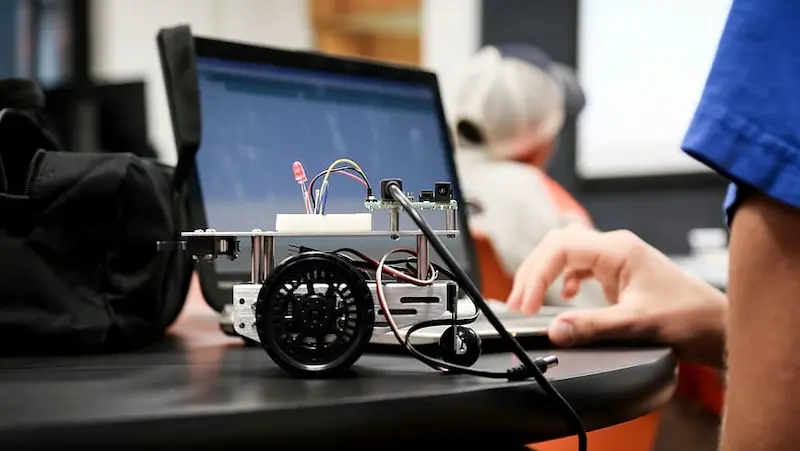
Cognitive Development
Engaging in robotics classes stimulates cognitive development in a way that textbooks simply can’t. Students learn to think critically and analytically as they tackle real-world challenges. From understanding complex instructions to troubleshooting issues with their creations, the process of building and programming robots demands a level of mental agility that fosters cognitive growth.
Problem-Solving Skills
Life is full of problems waiting to be solved, and robotics classes are like training grounds for future solvers. Participants are immersed in an environment where problem-solving is not a theoretical concept but a hands-on necessity. Whether it’s figuring out why a sensor isn’t working or modifying code to enhance functionality, these classes hone problem-solving skills that are applicable far beyond the world of robotics.
Teamwork and Collaboration
No robot is an island, and neither are the students in robotics classes. Collaboration is woven into the fabric of these programs, as students work together to bring their creations to life. Learning to communicate ideas, share responsibilities, and appreciate diverse perspectives are invaluable skills that extend well beyond the robotics lab. In a world that increasingly values teamwork, these classes offer a head start in mastering the art of collaboration.
Choosing the Right Robotics Class
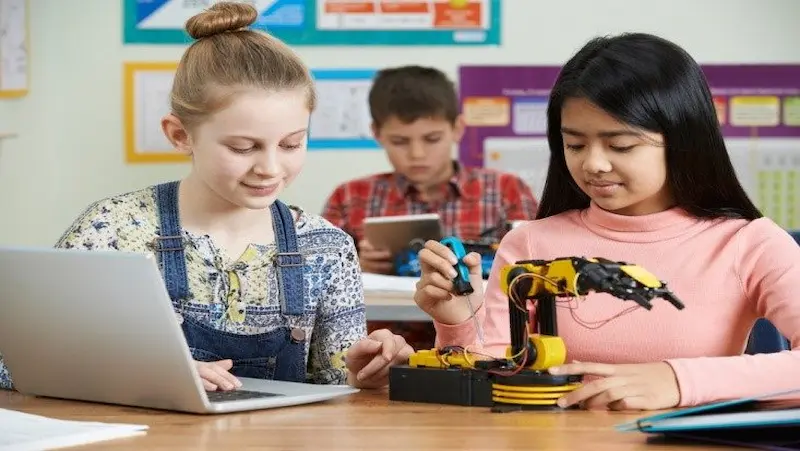
Location and Accessibility
First things first – where is the class located? Accessibility is more than just convenience; it’s about creating an environment that promotes consistent attendance and engagement. Opt for a class that is easily reachable, whether it’s close to home, school, or work. This ensures that attending sessions doesn’t turn into a daunting task, making it more likely for participants to stay committed.
Consider the commuting time and transportation options available. A class that is a stone’s throw away can be a game-changer, allowing participants to focus on the exciting challenges of robotics rather than navigating through traffic.
Age-Appropriate Programs
Robotics is for everyone, regardless of age, but the learning experience should align with the participant’s developmental stage. Check if the class offers age-appropriate programs designed to cater to the needs and interests of different age groups.
For the younger enthusiasts, a class that incorporates playful learning methods can spark curiosity and lay the foundation for future STEM interest. Older participants might benefit from more advanced challenges that align with their cognitive abilities. A well-structured program ensures that everyone feels both challenged and supported, creating an environment where every aspiring roboticist can thrive.
Curriculum and Learning Approach
Not all robotics classes are created equal, so it’s crucial to delve into the curriculum and teaching approach. Look for a class that strikes a balance between theoretical knowledge and hands-on experience. The best learning happens when participants can apply what they’ve learned to real-world projects.
Review the curriculum to ensure it covers a broad range of topics, from basic robotics principles to more advanced concepts. A holistic approach allows participants to develop a comprehensive understanding of robotics, preparing them for future challenges in the field.
Consider the learning style that best suits you or your child. Some classes may focus on collaborative projects, fostering teamwork and communication skills. Others may emphasize individual exploration, allowing participants to delve into their specific interests. The ideal class aligns with the preferred learning style, creating an engaging and enjoyable educational experience.
Popular Robotics Platforms

LEGO Mindstorms: Building Dreams, One Brick at a Time
LEGO Mindstorms, with its iconic interlocking bricks, isn’t just for building castles and spaceships anymore. This beloved platform introduces aspiring engineers to the exciting realm of robotics. The customizable LEGO elements seamlessly blend with programmable bricks, motors, and sensors, empowering users to craft their own intelligent robots. It’s like bringing your LEGO creations to life, and the best part? No need to be a tech genius – Mindstorms is designed for all skill levels.
VEX Robotics: Unleashing Creativity through Competition
If you’re someone who thrives on competition and craves a challenge, VEX Robotics might be your perfect match. VEX offers an array of kits and components that cater to various skill levels. From simple snap-together pieces for beginners to advanced programmable modules for seasoned engineers, VEX Robotics encourages creativity, problem-solving, and, of course, healthy competition. It’s a fantastic platform for those looking to build robots that not only impress but also excel in the arena.
Ozobot: Tiny but Mighty Tech Companions
Enter the world of Ozobot, where small robots make a big impact. Ozobot is all about making coding and robotics accessible to everyone, regardless of age or experience. These palm-sized robots follow color-coded lines and respond to simple commands, making them the perfect introduction to the world of coding for young learners. Ozobot seamlessly blends education with fun, offering a hands-on experience that sparks curiosity and creativity in the realm of technology.
Age Groups and Skill Levels

Beginners (Ages 6-8): The Building Blocks Phase
For our youngest learners, aged 6 to 8, the world of STEM is a playground filled with curiosity and wonder. At this stage, it’s all about laying down the foundation – think of it as building with colorful blocks. STEM activities for beginners should be hands-on, engaging, and, most importantly, fun!
Activities like simple experiments, basic coding with interactive games, and exploring the magic of numbers through puzzles can captivate their imaginations. The focus is on sparking interest and cultivating a positive attitude towards STEM subjects, making learning a delightful experience.
Intermediate (Ages 9-11): The Exploration Period
As our young learners step into the 9 to 11 age group, it’s time to explore the vast landscape of STEM knowledge. Think of it as a journey through uncharted territories where every discovery is a milestone. At this stage, hands-on projects that encourage problem-solving and critical thinking become essential.
Intermediate learners can delve into more complex coding exercises, engage in robotics projects, and explore basic engineering concepts. It’s about encouraging them to ask questions, make connections, and experiment with their ideas. The goal is to foster a sense of curiosity that propels them to learn more about the fascinating world of STEM.
Advanced (Ages 12-15): The Mastery Phase
Now, as our young minds transition into the 12 to 15 age group, they enter the mastery phase. It’s time to fine-tune those STEM skills and delve deeper into specialized areas. Think of it as honing the craft, much like an apprentice becoming a master.
Advanced learners can tackle more intricate coding challenges, delve into advanced robotics, and explore higher-level mathematical concepts. It’s also an opportune time to introduce real-world applications of STEM, showcasing the impact these fields have on various industries. Encouraging them to take on ambitious projects and pursue their specific interests within STEM can set the stage for future innovation.
Importance of Trained Instructors

Certified Robotics Instructors
Imagine embarking on a robotics journey with someone who not only knows their way around the intricacies of the subject but has the certified badge to prove it. Certified robotics instructors bring a wealth of knowledge and expertise to the table, ensuring that students are guided by individuals who have met rigorous standards in the field. Their certification serves as a testament to their dedication, proficiency, and commitment to delivering a high-quality educational experience.
Experience and Qualifications
Experience matters, and when it comes to the world of robotics, it can be a game-changer. Trained instructors with hands-on experience in the field bring real-world insights into the classroom. Their practical know-how adds a layer of depth to theoretical concepts, making learning not only informative but also engaging. Qualifications, alongside experience, provide a solid foundation for effective teaching. A mix of academic prowess and practical application ensures that instructors are equipped to address the diverse needs of students.
Student-to-Instructor Ratio
Picture this: a classroom buzzing with the excitement of students eager to explore the wonders of robotics. Now, envision a setting where the student-to-instructor ratio is carefully balanced. A lower student-to-instructor ratio ensures that each learner receives personalized attention, fostering a conducive environment for questions, discussions, and individualized guidance. This close interaction promotes a deeper understanding of the subject matter, creating a learning atmosphere where no question is too small, and no concept is left unexplored.
Real-World Applications

Robotics in Everyday Life
Remember when robots were just a thing from sci-fi movies? Well, guess what? They’ve crashed into our daily routine like that cool friend who always brings excitement to the party. From the little Roomba vacuuming our floors to automated assembly lines whipping up everything from cars to smartphones, robots are the backstage crew making life smoother.
But it’s not just about convenience. Think about medical surgeries, where precision is a must. Robots are lending a helping hand to surgeons, making procedures safer and more efficient. Imagine that, a robot assisting in fixing you up – the future is now!
Future Career Opportunities
Hold on to your hats, because the job market is getting a futuristic makeover. As robots become our sidekicks in various industries, there’s a whole new world of career opportunities opening up. Sure, coding and programming are still cool, but now there’s a demand for folks who can design, maintain, and troubleshoot these metallic marvels.
Picture this: you could be the brain behind the next-gen robot that saves lives in hospitals or the tech genius who programs drones for environmental surveys. The possibilities are expanding, and the job market is hungry for creative minds ready to embrace the robotic revolution.
Inspiring Success Stories
Now, let’s sprinkle some inspiration on this robotic adventure. Ever heard of a young mind named Easton LaChappelle? This guy started building his own robotic arm in his bedroom at 14! Fast forward, and he’s now a tech entrepreneur, shaking hands with big shots in the industry. If that doesn’t scream ‘you can do it too,’ I don’t know what does.
Then there’s the story of Sophia, the humanoid robot who not only looks like a character straight out of a sci-fi novel but has also become a citizen of Saudi Arabia. Sophia’s creator, Dr. David Hanson, brought a robot to life, showcasing the incredible potential of merging artificial intelligence with human-like features.
These success stories aren’t just about technology; they’re about the humans behind the machines, proving that with a dash of passion and a sprinkle of curiosity, anyone can contribute to the world of robotics.
Hands-On Learning Activities
Building Robots: Unleash Your Inner Engineer
Imagine a classroom filled with buzzing excitement as students huddle together, armed with wires, gears, and a common goal – building robots! Building robots is not just about assembling metal parts; it’s about fostering teamwork, problem-solving, and unleashing the inner engineer in each participant.
As students tinker with circuits and sensors, they learn the practical application of scientific principles. Beyond the technical skills, building robots cultivates patience and resilience. When a robot doesn’t work as expected, students don’t just give up. Instead, they collaborate, troubleshoot, and discover the joy of overcoming challenges, laying the groundwork for lifelong learning.
Coding Exercises: Cracking the Code to Innovation
In the digital age, coding has become a universal language, and hands-on coding exercises are the key to fluency. Picture students engrossed in the rhythmic dance of fingers on keyboards, translating ideas into lines of code. Coding exercises not only teach the syntax of programming languages but also nurture logical thinking and problem-solving skills.
As students grapple with coding challenges, they discover the thrill of turning a blank screen into a dynamic program. Mistakes are not failures but stepping stones to success. Coding exercises instill a growth mindset, where errors are viewed as opportunities to learn and improve. This mindset is not just beneficial in the realm of technology but serves as a valuable life skill in facing challenges head-on.
Team Challenges: The Power of Collaboration
Team challenges bring a sense of camaraderie into the learning environment. Whether it’s solving a complex puzzle, tackling a problem-solving task, or collaborating on a project, the power of teamwork is undeniable. In a world that values collaboration, team challenges equip students with the interpersonal skills necessary for success.
Participating in team challenges goes beyond academic knowledge; it fosters communication, leadership, and the ability to navigate diverse perspectives. Students learn to appreciate the strengths of their peers, fostering a sense of unity and collective achievement. These challenges prepare students for the collaborative nature of the real world, where innovative solutions often emerge from the synergy of diverse minds working together.
Showcasing Student Projects

Robotics Exhibitions
Our school corridors recently transformed into a hub of whirring gears and buzzing excitement during our latest Robotics Exhibition. Picture this: small, enthusiastic teams huddled around their meticulously crafted robots, showcasing their prowess in design and programming. Parents, teachers, and fellow students marveled at the ingenuity on display.
From navigating obstacle courses to completing complex tasks, these young engineers demonstrated not only technical know-how but also teamwork and problem-solving skills. It was heartening to witness the confidence and pride in our students as they explained their creations, leaving everyone in awe of their dedication and determination.
Competitions and Awards
We believe in fostering a competitive spirit that encourages our students to push their boundaries. Whether it’s a coding competition or a science fair, our students consistently rise to the challenge. The gleam in their eyes upon receiving awards is infectious, reflecting the countless hours of hard work and passion they’ve poured into their projects.
These competitions not only serve as a platform for recognition but also cultivate a sense of healthy competition. The joy of achievement is palpable, and it’s evident that our students are not just gaining knowledge; they are developing skills that will serve them well in the future.
Parent Involvement
Our students’ success is a team effort, and we believe in the power of parent involvement. Picture the excitement of parents attending project showcases, witnessing firsthand the growth and capabilities of their children. The joy and pride on their faces are priceless.
We encourage parents to actively participate in their child’s educational journey, offering support and encouragement. Whether it’s assisting with project materials, attending workshops, or cheering from the sidelines during competitions, our parents play a crucial role in nurturing the talents of our students.
Safety Measures in Robotics Classes
Equipment Safety:
Imagine a robotics workshop as a high-tech playground, where gadgets and gizmos replace swings and slides. Just like in any playground, safety comes first. In the robotics realm, this translates to paying close attention to equipment safety.
Ensure that all robotic tools and devices are in good working condition before use. Frayed wires, loose connections, or malfunctioning components should be addressed promptly. Don’t hesitate to ask for help or report any issues to the instructor.
Wearing the appropriate protective gear is as crucial as strapping on a helmet before riding a bike. Safety glasses, gloves, and other protective equipment should be worn to shield against potential hazards. It might not make you look like a sci-fi hero, but it’ll certainly keep you safe and sound.
Supervision and Emergency Protocols:
In the world of robotics, teamwork is essential, and so is having a watchful eye over the entire process. Teachers and instructors play a pivotal role in ensuring a safe learning environment.
Always follow the guidelines and instructions provided by your instructor. Listen up during safety briefings – they’re not just background noise. In case of any doubts or concerns, don’t hesitate to seek clarification. Remember, asking questions doesn’t make you less cool; it makes you smarter and safer.
Emergency protocols are like the secret superhero powers of a robotics class. Know where emergency exits are, understand evacuation plans, and be aware of first aid locations. It might seem like a lot to take in, but it’s the safety net that ensures everyone can enjoy the robotic adventure without worries.
Age-Appropriate Tools:
Just like how you wouldn’t give a toddler a power drill, age-appropriate tools are a must in robotics classes. Different age groups require different levels of complexity in their tools and projects.
Teachers, parents, and students – work together to choose projects and tools that match the skill level and maturity of the participants. It’s not about holding back creativity; it’s about ensuring that everyone can participate safely and confidently.
Integrating STEM Concepts

Science Connections: Unraveling the Mysteries
Science is all around us, from the plants in our gardens to the stars in the night sky. Integrating STEM begins with nurturing a sense of curiosity about the natural world. Imagine a science class where students explore the principles of biology by creating a mini-ecosystem or investigate chemistry through hands-on experiments. By connecting scientific theories to real-world phenomena, students not only absorb knowledge but also develop a profound appreciation for the wonders of the universe.
Technology Applications: Bringing Ideas to Life
In today’s digital era, technology is the driving force behind innovation. Integrating technology into STEM education means going beyond textbooks and embracing interactive tools. Imagine students coding a program to simulate environmental changes or designing a website to showcase their science projects. By immersing learners in practical applications, technology becomes a powerful ally in transforming theoretical concepts into tangible solutions.
Engineering Principles: Building the Future
Engineering is about problem-solving and turning ideas into reality. Integrating engineering principles into STEM education encourages students to think like inventors and builders. Picture a classroom where students construct bridges from everyday materials to test their strength or design simple machines to understand the basics of physics. This hands-on approach not only makes engineering concepts more accessible but also cultivates a mindset that values creativity and resilience in the face of challenges.
Math in Robotics: A Formula for Fun Learning
Mathematics is often considered a daunting subject, but integrating it with robotics can change that perception. Think of students using mathematical concepts to program a robot’s movements or calculate the angles needed for precise tasks. By incorporating math into the realm of robotics, students see the practical applications of what they learn in class. This not only makes math more relatable but also sparks an interest in the intricate connection between numbers and the physical world.
Customizing Learning Paths
Tailoring Classes to Individual Interests
Imagine a world where your education aligns seamlessly with your passions and interests. Well, it’s not just a dream – it’s the beauty of tailoring classes to individual interests. We’re talking about customizing your learning journey so that every lesson sparks your curiosity and enthusiasm.
Think about it like this: if you’re passionate about astronomy, why not explore physics through the lens of celestial bodies? Customizing your learning path allows you to dive deep into subjects that truly captivate you. This isn’t about fitting a square peg into a round hole; it’s about shaping your education to suit your unique interests, making the entire learning process more engaging and fulfilling.
Adaptive Learning Strategies
No two learners are exactly alike. We all have different paces, strengths, and areas where we can improve. That’s where adaptive learning strategies come into play. Instead of sticking to a rigid structure, these strategies adjust to your needs, providing a more personalized learning experience.
It’s like having a mentor who understands when you need an extra challenge or a bit more time to grasp a concept. Adaptive learning strategies recognize your strengths and weaknesses, helping you progress at your own pace. Whether you’re a quick learner eager for more challenges or someone who benefits from a bit more review, adaptive strategies cater to you, making the educational journey smoother and more effective.
Progress Tracking
Ever wished you had a roadmap to your learning journey? Well, progress tracking is your personalized GPS. It’s not just about ticking off completed lessons; it’s about understanding how far you’ve come and where you’re headed.
Picture this: you set out on a road trip, and at each milestone, you glance at the map to see the distance covered. Similarly, progress tracking in education lets you see the strides you’ve made, boosting your confidence and motivating you to keep going. It’s a valuable tool that empowers you to take charge of your learning, celebrating achievements and identifying areas that may need a bit more attention.
Making Robotics Fun

Gamified Learning
Imagine learning robotics through a game – it’s not only possible but incredibly effective! Gamified learning takes the often complex concepts of robotics and turns them into exciting challenges and missions. Kids can step into the shoes of a virtual engineer, solving puzzles and overcoming obstacles to unlock new levels and achievements.
Whether it’s programming a robot to navigate a maze or designing a virtual world for their creations, gamified learning makes the educational journey interactive and entertaining. As they conquer challenges, kids not only grasp the fundamentals of robotics but also develop problem-solving skills and a love for exploration.
Interactive Challenges
Hands-on experiences are key to making robotics fun. Interactive challenges allow kids to apply what they’ve learned in a practical and engaging manner. Picture a room filled with eager faces as youngsters collaborate to build and program their robots, all while facing exciting challenges.
These challenges can range from simple tasks like making a robot follow a line to more complex endeavors like creating a robot soccer team. The thrill of seeing their creations come to life and perform tasks is a powerful motivator, turning each challenge into a source of pride and accomplishment.
By fostering a sense of curiosity and experimentation, interactive challenges not only teach robotics concepts but also instill a passion for discovery and innovation.
Themed Robotics Sessions
What if robotics class felt more like an epic adventure or a journey to uncharted territories? Themed robotics sessions add an extra layer of excitement by creating immersive environments and storylines. From exploring the depths of the ocean to embarking on a space mission, each session becomes a unique and thrilling experience.
Themed sessions spark creativity as kids design robots tailored to fit the storyline. It’s not just about learning programming or engineering; it’s about bringing their imaginations to life. By incorporating storytelling into robotics education, we tap into the natural inclination of children to explore and create.
Parental Involvement and Support

Understanding the Learning Process
Understanding how your child learns is like having a treasure map to unlock their potential. Each child is unique, and grasping their individual learning style is key. Some kids thrive with hands-on activities, while others might prefer reading or listening. Talk to your child about their school experiences, their challenges, and the subjects that excite them. This dialogue fosters a supportive environment where learning becomes a shared adventure. By actively engaging in their academic journey, you not only show them that education matters, but you also provide a solid foundation for growth.
Encouraging Continued Exploration
Education is not a sprint; it’s a lifelong marathon filled with twists, turns, and unexpected detours. Encourage your child to explore different subjects and hobbies. Share stories of your own journey of self-discovery, emphasizing that it’s okay not to have everything figured out at a young age. Celebrate their achievements, no matter how small, and remind them that setbacks are stepping stones to success. A nurturing environment at home bolsters their confidence, enabling them to face challenges head-on. By instilling a love for learning, you’re giving them the tools to adapt, evolve, and embrace the ever-changing landscape of knowledge.
Building a Home Robotics Kit
Enter the fascinating world of hands-on learning with the idea of building a home robotics kit. This isn’t just about assembling gears and wires; it’s about igniting a passion for science, technology, engineering, and math (STEM). A home robotics kit is like a mini laboratory where curiosity takes the lead. Work together with your child, following step-by-step instructions, troubleshooting challenges, and celebrating the joy of creating something functional. This not only enhances their problem-solving skills but also opens doors to potential future interests and careers. Plus, it’s a fantastic bonding experience that transforms learning into a shared adventure.
Affordability and Financial Assistance
Budget-Friendly Options
When it comes to education, one size doesn’t fit all, and the same holds true for the cost. Institutions understand this, and many offer budget-friendly options that cater to diverse financial situations.
Community colleges, for instance, are renowned for providing quality education at a fraction of the cost of traditional four-year universities. By starting your academic journey at a community college, you can save significantly on tuition fees while still enjoying a robust educational experience.
Moreover, online courses have become a game-changer in the affordability landscape. With the flexibility to learn from the comfort of your home, online education often comes with lower tuition costs, reduced commuting expenses, and the ability to maintain a job while pursuing your studies.
Scholarship Opportunities
Scholarships are like hidden treasures waiting to be discovered, and they can make a substantial impact on reducing your educational expenses. These financial aids are not limited to the academically gifted; there are scholarships for a myriad of talents and interests.
Whether you excel in sports, arts, or community service, there’s likely a scholarship tailored just for you. Many organizations, both local and national, offer scholarships to support deserving students in their educational endeavors. It’s worth investing some time in researching and applying for these opportunities, as they can significantly lighten the financial load.
Family Discounts
For those with siblings or family members sharing the educational journey, family discounts can be a lifeline. Many institutions understand the financial strain on families with multiple members pursuing education simultaneously. As a result, they often provide discounts or financial incentives to families with more than one enrolled student.
These family discounts can make a significant difference in the overall cost of education for each family member. It’s advisable to check with the admissions or financial aid office of your chosen institution to explore the possibilities of such discounts.
Community Impact

Building a Robotics Community
At the heart of what we do lies a genuine passion for bringing people together through the fascinating world of robotics. We believe in the power of shared enthusiasm and collaborative learning. Our robotics community is more than just a gathering of like-minded individuals; it’s a hub of inspiration, where ideas flow freely, and innovation knows no bounds.
Imagine a space where seasoned experts and curious beginners can exchange ideas, troubleshoot problems, and celebrate triumphs together. That’s the kind of community we are building—one that thrives on camaraderie, encourages mentorship, and fuels the collective passion for all things robotics.
Outreach Programs
Our commitment to making a positive impact extends beyond the confines of our community. Through a series of outreach programs, we strive to bridge gaps, inspire young minds, and spark an interest in the fascinating realm of robotics.
Picture this: workshops that bring the wonders of robotics to local neighborhoods, inspiring the next generation of inventors and problem solvers. Our outreach programs are designed to break down barriers, making the world of technology accessible to all. Whether it’s through hands-on activities, interactive demonstrations, or engaging presentations, we aim to ignite the spark of curiosity and passion for robotics in the broader community.
Collaborations with Schools
Education is the cornerstone of a thriving society, and we believe in playing our part. By forging meaningful collaborations with schools, we aim to integrate robotics seamlessly into educational curricula. The goal? To empower students with the skills and knowledge they need to navigate the ever-evolving landscape of technology.
Our partnerships with schools go beyond providing equipment. We work hand-in-hand with educators, offering resources, training, and ongoing support to ensure that robotics becomes an engaging and integral part of the learning experience. Through these collaborations, we aspire to cultivate a generation that not only embraces technology but also shapes its future.
Robotics Class Trends
Emerging Technologies: Where Imagination Meets Reality
Step into any robotics class today, and you’ll likely encounter a fascinating array of emerging technologies that seem straight out of a sci-fi movie. From advanced sensors that mimic human perception to nimble drones that can navigate complex environments, students are getting their hands dirty with cutting-edge tools that push the boundaries of what’s possible.
Imagine creating a robot that not only moves but also understands its surroundings through sophisticated vision systems. These emerging technologies are not just about building robots; they’re about unleashing creativity and problem-solving skills in students, preparing them for the challenges of the future.
Industry Partnerships: Bridging the Gap Between Classroom and Career
One of the most exciting aspects of today’s robotics classes is the growing collaboration between educational institutions and industry leaders. These partnerships provide students with a unique opportunity to apply their skills in real-world scenarios and gain insights into the demands of the job market.
Companies are actively seeking out fresh talent from these classrooms, recognizing the value of hands-on experience and innovative thinking. This collaboration not only benefits students by offering a bridge to potential careers but also enriches the industry with fresh perspectives and ideas.
Future Developments: Paving the Way for Tomorrow’s Innovators
As we look ahead, the future of robotics education promises even more exciting developments. With the rise of artificial intelligence and the Internet of Things, robotics classes are evolving to incorporate interdisciplinary skills, preparing students for the increasingly interconnected nature of technology.
Expect to see a shift towards more project-based learning, where students tackle real-world problems and design solutions using a holistic approach. The focus will be on cultivating not just technical skills but also critical thinking, collaboration, and adaptability — skills that will be crucial in the dynamic landscape of the 21st century.
Conclusion
In conclusion, diving into robotics classes is like unlocking a door to a world of endless possibilities. It’s not just about nuts and bolts; it’s about sparking creativity, solving real-world problems, and gaining skills that will shape the future. Enrolling in robotics classes isn’t just a choice; it’s an investment in yourself and the world around you. So, take that leap, embrace the challenges, and let the journey into the exciting realm of robotics begin. Who knows, you might just be building the next big thing that changes the way we live, work, and play. The adventure awaits, and with each lesson, you’re one step closer to becoming a true robotics whiz!
To get your hands on more such articles, educational content, and free resources on coding classes for kids, online robotics classes for kids, game development, etc., check out the BrightCHAMPS Page now!
Frequently Asked Questions
A1. The age that’s just right for diving into robotics classes varies, but generally, kids as young as 8 years old can get started. It’s more about the child’s interest and ability to grasp concepts than a specific age.
A2. Finding the best robotics class is like hunting for treasure! Ask around in your community, check online reviews, and visit open houses if possible. Word of mouth and the experiences of other parents can guide you to the perfect spot.
A3. In robotics classes, kids pick up cool skills like problem-solving, teamwork, and a bit of coding magic. They get hands-on with technology, learning to design, build, and program robots – skills that sneakily prepare them for the future!
A4. It’s a bit like comparing apples and oranges. Both have their perks! Online classes offer flexibility, while in-person ones provide hands-on interactions. The key is finding what suits your child best. Some young tech whizzes love the online vibes, while others thrive in a physical classroom.
A5. Dive into the world of robotics together! Start with beginner-friendly kits, explore online tutorials, and be their tech sidekick. Encourage curiosity, celebrate small victories, and turn “I don’t know” into a fun exploration at home.
A6. Picture this: Robotics classes are like the superheroes of STEM education. They swoop in, making Science, Technology, Engineering, and Math exciting and real. Kids learn problem-solving, critical thinking, and tech skills – all wrapped up in the cool world of robots!

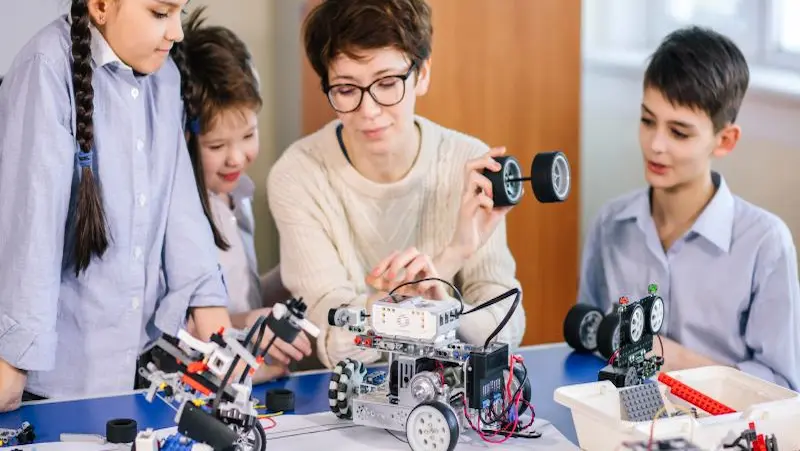
 We are an army of educators and passionate learners from BrightChamps family, committed to providing free learning resources to kids, parents & students.
We are an army of educators and passionate learners from BrightChamps family, committed to providing free learning resources to kids, parents & students.








